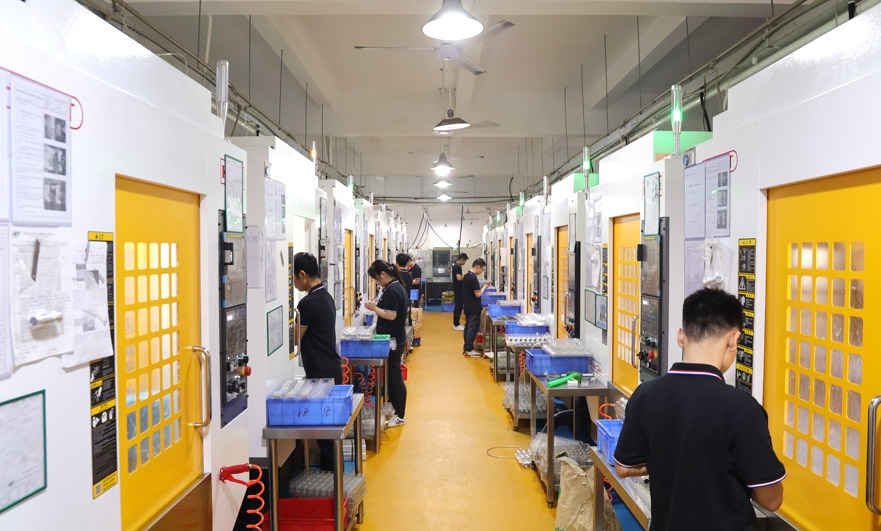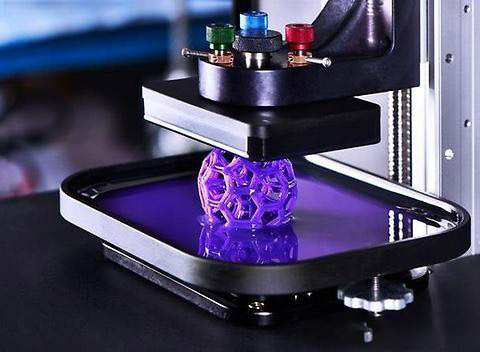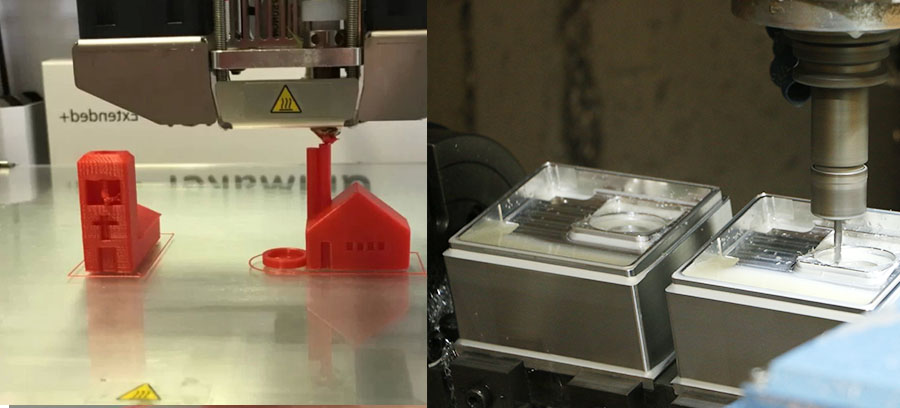15 years one-stop China custom CNC machining parts factory
 209 |
Published by VMT at May 13 2023
209 |
Published by VMT at May 13 2023
In the world of rapid CNC prototyping, two prominent techniques stand out: CNC machining and 3D printing. Both methods offer unique advantages and cater to different prototyping needs.
CNC prototyping machining is the process of creating a physical prototype of a product or component using specialized equipment such as CNC (Computer Numerical Control) machines. It involves using a digital design or blueprint to create a 3D model of the product, which is then translated into machine code and used by the CNC machine to carve or cut the material into the desired shape.

Prototype machining allows manufacturers and designers to create a functional model of their product before moving into full-scale production. This process allows for adjustments to be made to the design and functionality of the product before investing in expensive tooling or production processes.
Prototype machining is commonly used in a variety of industries, including aerospace, automotive, medical, and consumer products. It enables manufacturers to test the design, functionality, and performance of their products in a cost-effective and efficient manner.
Product items often need to be CNC prototyped machining. CNC prototyping machining is the first step to verify product feasibility. It is the most direct and effective way to find out the defects, deficiencies, and drawbacks of the designed products, so as to improve the defects in a targeted manner, save expensive mold opening costs, reduce R&D risks, and speed up R&D efficiency.
3D printing, also known as additive manufacturing, is a revolutionary technology that has transformed the way we create physical objects. Unlike traditional manufacturing methods that involve subtracting material from a solid block, 3D printing builds objects layer by layer using a digital model.

Here's how the 3D printing process works:
Digital Design: The first step in 3D printing is creating a digital design of the object you want to create. This can be done using computer-aided design (CAD) software or by scanning an existing object using 3D scanning technology. The digital design serves as the blueprint for the 3D printer.
Slicing: Once the digital design is ready, it is sliced into thin cross-sectional layers using specialized software. Each layer is then converted into instructions that the 3D printer can understand.
Printing: The 3D printer starts the printing process by depositing or solidifying material layer by layer according to the instructions received. The materials used in 3D printing can vary and include plastics, metals, ceramics, resins, and even food or biological materials.
Layer Bonding: As each layer is added, the 3D printer ensures that it bonds or fuses with the previous layer. This bonding process can be achieved through various methods, such as melting plastic filaments, curing liquid resins with UV light, or sintering metal powders with lasers.
Completion and Post-Processing: Once the printing is complete, the object is removed from the 3D printer. Depending on the specific requirements, post-processing steps may be necessary, such as removing support structures, polishing the surface, or applying additional treatments to enhance the final appearance or functionality of the printed object.
When it comes to rapid prototyping, two popular methods are CNC machining and 3D printing. While both techniques serve the purpose of creating prototypes, they have distinct differences and offer unique advantages. Let's explore the disparities and advantages of each method:

Rapid CNC Prototyping Machining:
Rapid CNC prototyping, also known as CNC machining, utilizes computer-controlled machines to carve or cut materials into the desired shape. It involves subtractive manufacturing, where excess material is removed from a solid block or billet to create the prototype. Here are the advantages of rapid CNC prototyping:
1. Material Selection: CNC machining offers a wide range of material options, including metals, plastics, composites, and even wood. This versatility allows for the selection of materials that closely match the desired properties and characteristics of the final product.
2. High Precision and Accuracy: CNC machines are known for their exceptional precision and accuracy. They can produce prototypes with tight tolerances and intricate details, making them suitable for applications that require high levels of precision.
3. Strength and Durability: As CNC prototypes are carved from solid blocks of material, they tend to be structurally robust and possess excellent strength and durability. This makes CNC prototypes suitable for testing functional aspects and mechanical properties of the product.
4. Surface Finish and Tolerance: CNC machining delivers superior surface finishes and allows for tighter tolerances compared to 3D printing. If your project requires smooth surfaces, precise dimensions, or tight tolerances, CNC machining is the way to go.
5. Suitable for Complex Designs: CNC machining can handle complex designs but may require more expertise and programming to execute intricate geometries. Nonetheless, it remains an excellent choice for intricate and functional prototypes.
3D Printing
3D printing, also known as additive manufacturing, involves building prototypes layer by layer using a digital model. This method offers its own set of advantages:
1. Speed and Cost Efficiency: 3D printing is generally faster and more cost-effective than CNC machining for complex and intricate designs. It eliminates the need for tooling and can rapidly produce prototypes, reducing both time and cost in the early stages of product development.
2. Design Complexity and Customization: 3D printing excels in creating highly complex geometries and intricate designs. It allows for the production of prototypes with intricate internal structures and customized features, making it ideal for personalized products or unique design elements.
3. Iterative Prototyping and Design Modifications: With 3D printing, design modifications and iterative prototyping are relatively easy. Changes can be made digitally, and the modified prototype can be printed without the need for extensive reprogramming or retooling. This allows for faster iteration and refinement of the design throughout the prototyping process.
4. Suitable for Concept Models and Visual Prototypes: 3D printing is particularly useful for concept models, visual prototypes, and presentations. It enables designers to showcase the form and aesthetics of a product, making it valuable for marketing and validation purposes.
5. Materials and Surface Finish Limitations: While 3D printing offers a variety of materials, the range may be limited compared to CNC machining. Additionally, the surface finish of 3D printed parts may not match the level of smoothness and precision achieved through CNC machining.
In summary, rapid CNC prototyping and 3D printing are two distinct methods for creating prototypes, each with its own set of advantages. Rapid CNC prototyping offers a wide range of material options, high precision, and durability, making it ideal for testing functional aspects and mechanical properties. On the other hand, 3D printing excels in creating complex geometries, providing speed, cost-efficiency, customization, and the ability to rapidly iterate on designs.
The choice between CNC machining and 3D printing depends on the specific requirements of the project, such as design complexity, material properties, budget, and time constraints. Understanding the differences and advantages of each method will help you make an informed decision and select the most suitable approach for your prototyping needs.
When deciding whether to opt for CNC machining or 3D printing for your prototype parts, several factors should be taken into consideration. Here are the key aspects to evaluate and guide your decision:
1. Complexity of the Design: Consider the complexity of your design. If your prototype requires intricate details, complex geometries, or internal structures, 3D printing may be the better choice. Its additive nature allows for the creation of complex shapes that may be challenging to achieve with CNC machining.
2. Material Selection: Assess the materials you intend to use for your prototype parts. CNC machining offers a broader range of material options, including metals, plastics, and composites. If your project requires specific material properties or requires testing with production-grade materials, CNC machining is more suitable. However, if you can achieve your desired functionality and aesthetics with 3D printing materials, it may be a viable and cost-effective option.
3. Strength and Durability Requirements: Consider the strength and durability requirements of your prototype parts. CNC machined parts are typically stronger and more robust due to being carved from solid blocks of material. If your prototype needs to undergo functional testing, experience mechanical stresses, or replicate the final product's physical properties, CNC machining may be the preferred choice.
4. Speed and Time Constraints: Evaluate the time constraints for your project. 3D printing can offer faster turnaround times, especially for complex designs, as it eliminates the need for tooling and reprogramming. It allows for rapid iteration and faster production of multiple design iterations. CNC machining, on the other hand, may have longer lead times due to the setup and programming required for each design.
5. Cost Considerations: Analyze your budget and cost considerations. CNC machining can be more expensive, particularly for complex designs or when using high-end materials. 3D printing, on the other hand, can be more cost-effective, especially for small quantities or intricate designs that would require complex machining setups.
6. Surface Finish and Tolerance Requirements: Consider the desired surface finish and tolerance requirements of your prototype parts. CNC machining offers superior surface finishes and tighter tolerances compared to 3D printing. If your prototype requires smooth surfaces, precise dimensions, or tight tolerances, CNC machining may be the preferable option.
7. Iterative Prototyping and Design Changes: Determine whether your project requires iterative prototyping and frequent design changes. 3D printing excels in this aspect, as it allows for easy design modifications and rapid production of updated prototypes. CNC machining, on the other hand, may involve more setup time and costs for each design iteration.
8. Volume and Production Considerations: Consider the volume of prototypes needed and the potential for scaling up production. CNC machining is well-suited for producing small to medium volumes of prototypes, while 3D printing can be more efficient for low-volume production or one-off prototypes.
9. Industry Applications: Assess the specific industry applications and requirements. CNC machining is commonly used in industries such as automotive, aerospace, and medical, where precision, durability, and functional testing are crucial. 3D printing finds applications in various fields, including architecture, consumer products, and jewelry, where design complexity, customization, and rapid prototyping are prioritized.
In conclusion, both CNC machining and 3D printing offer distinct advantages for prototyping. CNC machining excels in precision, material versatility, and strength, making it ideal for functional testing and mechanical properties. On the other hand, 3D printing offers speed, customization, and the ability to handle complex designs, making it suitable for concept models, visualization, and low-volume production.
By carefully evaluating these factors, design complexity, material selection, strength and durability requirements, speed, cost, surface finish and iterative prototyping manufacturing needs, etc. You can decide whether CNC machining or 3D printing is best for your prototyping requirements.
